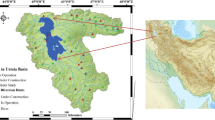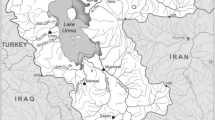Abstract
The rivers-connected lake involved in the “River–Lake-Reservoir” hydrological complex system and it's water level fluctuations are more severe than those of other lakes, which challenges the scientific management of lakes. Therefore, to improve the accuracy of water level prediction for the rivers-connected lake, taking Hongze Lake as an example, we used the BFAST algorithm to analyze the inconsistency of the lake's inter-annual water level and selected a stable stage for water level prediction research. Next, considering the lake basin shape, based on the Stage-discharge relationship curve, the fluctuation process of the lake's inter-annual water level was divided into four periods: the discharge period, the early period of storage, the later period of storage, and the balance period. Then, the NARX model was used to build the water level prediction model for different periods. Finally, the wavelet analysis and KNN algorithm were introduced into the water level prediction model for input data pre-process and result post-processing, respectively. The result shows that: (1) There are significant differences in the mechanism of water level regime modification in different periods. The outflowing runoff is the main driving factor for the water level regime modification in most times; (2) Coupling multiple machine learning methods is an effective way to improve the accuracy of the lake water level prediction; (3) The combination of the staged-divided water level prediction method and the hybrid machine learning models can further improve the accuracy of the water level prediction.










Similar content being viewed by others
Code availability
The NARX Model (NARXNET Function), Wavelet Analysis (WAVEDEC Function) and KNN Algorithm were carried out by programming in MATLAB Software (Version R2017a). The BFAST Model (BFAST Packages), Multiple Regression Analysis Model (LM Function), and Flood Season Staging Methods were carried out by R languages (Version 3.5.1).
References
Barzegar R, Adamowski J, Moghaddam AA (2016) Application of wavelet-artificial intelligence hybrid models for water quality prediction: a case study in Aji-Chay River. Iran Stoch Environ Res Risk Assess 30(7):1797–1819
Chen S, Billings SA, Grant PM (1990) Non-linear system identification using neural networks. Int J Control 51(6):1191–1214
Çimen M, Kisi O (2009) Comparison of two different data-driven techniques in modeling lake level fluctuations in Turkey. J Hydrol 378(3–4):253–262
Dargahi B, Setegn SG (2011) Combined 3D hydrodynamic and watershed modelling of Lake Tana. Ethiopia J Hydrol 398(1–2):44–64
Deng B, Liu SD, Xiao W, Wang W, Jin JM, Lee XH (2013) Evaluation of the CLM4 Lake model at a large and shallow freshwater lake. J Hydrometeorol 14(2):636–649
Ding W, Ma Y, Du SL, Li HC, Ding GB, Wang C (2020) Mining trend similarity of multivariate hydrological time series based on XGBoost algorithm. Comput Sci 47(S2):459–463
Guo Y, Lai XJ (2020) Water level prediction of Lake Poyang based on long short-term memory neural network. J Lake Sci 32(03):865–876 (in Chinese)
Han T, Li ZJ, Liu KL, Huang PN (2015) Research on real-time correction method of flood forecasting in small mountain watershed. J Hohai Univ (Nat Sci) 43(03):208–214 (in Chinese)
Hassanzadeh E, Zarghami M, Hassanzadeh Y (2012) Determining the main factors in declining the Urmia Lake level by using system dynamics modeling. Water Resour Manag 26(1):129–145
He Z, Wan RR, Dai X, Yang GS (2015) Characteristics of the changing seasonal water regime in Lake Dongting and their response to the change of river-lake water exchange in recent 30 years. J Lake Sci 27(06):991–996 (in Chinese)
Heiskanen JJ, Mammarella I, Ojala A, Stepanenko V, Erkkila KM, Miettinen H, Sandstrom H, Eugster W, Lepparanta M, Jarvinen H, Vesala T, Nordbo A (2015) Effects of water clarity on lake stratification and lake-atmosphere heat exchange. J Geophys Res Atmos 120(15):7412–7428
Hrnjica B, Bonacci O (2019) Lake level prediction using feed forward and recurrent neural networks. Water Resour Manag 33(7):2471–2484
Hu Q, Feng S, Guo H, Chen GY, Jiang T (2007) Interactions of the Yangtze River flow and hydrologic processes of the Poyang Lake. China J Hydrol 347(1–2):90–100
Kan GY, Yao C, Li QL, Li ZJ, Yu ZB, Liu ZY, Ding LQ, He XY, Liang K (2015) Improving event-based rainfall-runoff simulation using an ensemble artificial neural network based hybrid data-driven model. Stoch Env Res Risk Assess 29(5):345–1370
Kan GY, Hong Y, Liang K (2018) Research on the flood forecasting based on coupled machine learning model. China Rural Water Hydropower 10:165–169 (in Chinese)
Karlsson M, Yakowitz S (1987) Nearest-neighbor methods for nonparametric rainfall-runoff forecasting. Water Resour Res 23(7):1300–1308
Lai XJ, Jiang JH, Yang GS, Lu XX (2013) Should the Three Gorges Dam be blamed for the extremely low water levels in the middle-lower Yangtze River? Hydrol Process 28(1):150–160
Lai X, Huang Q, Zhang YH, Jiang JH (2014) Impact of lake inflow and the Yangtze River flow alterations on water levels in Poyang Lake. China Lake Reserv Manag 30(4):321–330
Lam D, Luis L, Hamiltion S, Crookshank N, Bonin D, Swayne D (2004) Multi-model integration in a decision support system: a technical user interface approach for watershed and lake management scenarios. Environ Modell Softw 19(3):317–324
Li YL, Zhang Q, Yao J, Li XH (2013) Integrated simulation of hydrological and hydrodynamic processes for Lake Poyang-catchment system. J Lake Sci 25(02):227–235
Li YL, Zhang Q, Yao J, Li MF (2015a) Advances in integrated hydrological and hydrodynamic simulation of lake-catchment system. Resourc Environ Yangtze Basin 24(02):263–270 (in Chinese)
Li YL, Zhang Q, Li M, Yao J (2015b) Using BP neural networks for water level simulation in Poyang Lake. Resourc Environ Yangtze Basin 24(02):233–240 (in Chinese)
Liu MY, Li QL, Li ZJ, Ma YN, Zhang HC, Jiang FQ, Yao YM (2019) The application of NARX neural network model based on wavelet analysis for water level prediction. South-to-North Water Transf Water Sci Technol 17(05):56–63 (in Chinese)
Luo Y, Dong ZC, Guan XK, Liu YH (2019) Flood risk analysis of different climatic phenomena during flood season based on Copula-based Bayesian Network method: A Case Study of Taihu Basin. China Water 11(8):1534
Luo Y, Dong ZC, Guan XK, Liu YH, Yuan JC (2020) Risk analysis of flood in the Taihu Basin during flood period based on Copula function. J Lake Sc 32(01):223–235 (in Chinese)
Mehmet üT, Carleton JN, Wellman M (2011) Integrated model projections of climate change impacts on a North American lake. Ecol Model 222(18):3380–3393
Mei HP, Wang ZL, Liu M, Zhou JM (2020) Variation rule of water level characteristic value of Hongze Lake during the past 50 years and influencing factors. J Yangtze River Sci Res Inst 04:1–7 (in Chinese)
Nourani V, Alami MT, Aminfar MH (2008) A combined neural-wavelet model for prediction of watershed precipitation, Ligvanchai. Iran Eng Appl Artif Intell 22(3):466–472
Nourani V, Hosseini BA, Adamowski J, Kisi O (2014) Applications of hybrid wavelet-artificial intelligence models in hydrology: a review. J Hydrol 514:358–377
Noury M, Sedghi H, Babazedeh H, Fahmi H (2014) Urmia lake water level fluctuation hydro informatics modeling using support vector machine and conjunction of wavelet and neural network. Water Resour 41(3):261–269
Pietroniro A, Leconte R, Toth B, Peters D (2006) Modelling climate change impacts in the Peace and Athabasca catchment and delta: III- integrated model assessment. Hydrol Process 20(19):4231–4245
Shoaib M, Shamseldin AY, Melville BW, Khan MM (2016) A comparison between wavelet based static and dynamic neural network approaches for runoff prediction. J Hydrol 535:211–225
Taner MÜ, Carleton JN, Wellman M (2011) Integrated model projections of climate change impacts on a North American lake. Ecological Modelling 222(18):3380–3393
Tang HW, Cao H, Yuan SY, Xiao Y, Gualtieri C (2020) A numerical study of hydrodynamic processes and flood mitigation in a large river-lake system. Water Resour Manag 34(12):3739–3760
Tu YM, Fu X, Yang HJ (2017) Lake daily level forecast by using mutual information: case of west Dongting Lake. Yangtze River 48(16):38–42 (in Chinese)
Verbesselt J, Hyndman R, Zeileis A, Culvenor D (2010) Phenological change detection while accounting for abrupt and gradual trends in satellite image time series. Remote Sens Environ 114(12):2970–2980
Wang MM, Dai LQ, Dai HC, Mao JQ, Liang L (2017a) Support vector regression based model for predicting water level of Dongting Lake. J Drain Irrig Mach Eng 35(11):954–961 (in Chinese)
Wang ZZ, Liu KL, Liu YC, Cheng L, Ye A (2020a) Optimizing the moderate size using floodwater in a large-scale shallow lake. Advances in Water Science 31(06):908–916 (in Chinese)
Wang ZZ, Liu KL, Cheng L, Qi SC, Tan LM (2017) Theoretical framework of floodwater resources utilization in a basin II: cases study. J Hydraul Eng 48(09):1089–1097 (in Chinese)
Wang WC, Chau KW, Dong MX, Chen XY (2015) Improving forecasting accuracy of annual runoff time series using ARIMA based on EEMD decomposition. Water Resour Manag 29(08):2655–2675
Wang YB, Sun T, Liang XC, Xie HY (2020) Prediction of river water flow and water level based on EMD-LSTM model. Adv Sci Technol Water Resour 40(06):40–47 (in Chinese)
Wu L, Li ZL, Liu XN, Zhu LH, Liu BY (2020) Multi-type forest change detection using BFAST and monthly landsat time series for monitoring spatiotemporal dynamics of forests in subtropical wetland. Remote Sens 12(2):341
Wu ML, Yang K, Zhang CC (2019) Application of KG-BP Neural Network in flood forecasting of Qinhuai River. Water Res Power 37(02):74–77 (in Chinese)
Wu XB (2009) Change of Hongze Lake over 60 years. China Water Res 14:21–23 (in Chinese)
Xu ZC, Xu SA (2008) Hongze Lake water conservancy projects and harmonious water culture. Water Res Develop Res 01:68–74 (in Chinese)
Xue CD, Wu H, Jiang XG (2019) Temporal and Spatial Change Monitoring of Drought Grade Based on ERA5 Analysis Data and BFAST Method in the Belt and Road Area during 1989–2017. Adv Meteorol 2019:1–10
Yadav B, Eliza K (2017) A hybrid wavelet-support vector machine model for prediction of Lake water level fluctuations using hydro-meteorological data. Measurement 103:294–301
Ye XC, Qi Z, Liu J, Li XH, Xu CY (2013) Distinguishing the relative impacts of climate change and human activities on variation of streamflow in the Poyang Lake catchment. China J Hydrol 494:83–95
Yin YX, Xu YP, Zhang XN, Jiao SX, Yan GX (2012) Forecasting characteristic water levels of Taihu Lake based on time series decomposing method. Bull Soil Water Conserv 32(04):172–175
Yu C, Chang QK, Xiao S (2020) Variations in water level, area and volume of Hongze Lake, China from 2003 to 2018. J Great Lakes Res 46(6):1511–1520
Zeynoddin M, Bonakdari H, Ebtehaj I, Azari A, Gharabaghi B (2020) A generalized linear stochastic model for lake level prediction. Sci Total Environ 723:138015
Zhai LN, Guan HL, Zhang ZL, Li G (2014) Research on the partition for the flood season of the Liangzi Lake. China Rural Water Hydropower 06:116–119 (in Chinese)
Zhang XL, Zhang Q, Wang XL (2017) Analysis on nonlinear hydrologic characteristics of stage-inflow relationship in Poyang Lake. Res Environ Yangtze Basin 26(05):723–729 (in Chinese)
Zhang H, Guo HH, Wang DL, Zhang XD (2011) Uncertainty assessment of climate change impacts on the hydrology of small prairie wetlands. J Hydrol 396(1–2):94–103
Zhu S, Lu HF, Mariusz P, Dai JY, Ji QF (2020) Lake water-level fluctuation forecasting using machine learning models: a systematic review. Environ Sci Pollut Res 27(36):44807–44819
Acknowledgements
We thank all reviewers and the editorial board of the issue for their constructive comments on initial draft of the paper.
Funding
This research was funded by the National Key Research and Development Program of China, grant number 2018YFC1508200. And the Major Projects of Water Conservancy Science and Technology Fund of Jiangsu Province, grant number 2019003.
Author information
Authors and Affiliations
Contributions
YL: Conceptualization; YL: Data curation; YL: Formal analysis; ZCD: Funding acquisition; YHL: Investigation; YL: Methodology; ZCD: Project administration; ZCD: Resources; XW: Software; ZCD: Supervision; QYS: Validation; YLH: Visualization; YL: Writing—original draft; YL: Writing—review and editing.
Corresponding authors
Ethics declarations
Conflict of interest
The authors declare no conflict of interest.
Additional information
Publisher's Note
Springer Nature remains neutral with regard to jurisdictional claims in published maps and institutional affiliations.
Rights and permissions
About this article
Cite this article
Luo, Y., Dong, Z., Liu, Y. et al. Research on stage-divided water level prediction technology of rivers-connected lake based on machine learning: a case study of Hongze Lake, China. Stoch Environ Res Risk Assess 35, 2049–2065 (2021). https://doi.org/10.1007/s00477-021-01974-6
Accepted:
Published:
Issue Date:
DOI: https://doi.org/10.1007/s00477-021-01974-6




